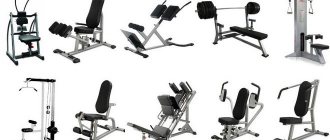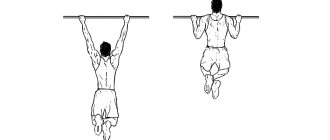- September 19, 2018
- Workouts in the gym
- Marina Semenyuk
For some, the time of training in a sports club is 40-45 minutes, for others – 1-1.5 hours. Are both theories correct? It turns out yes. Now, it remains to find out why.
Duration of strength training in the gym
It is important for a novice bodybuilder to know how long a workout in the gym should last if the emphasis is on mass. This time is about 1-1.5 hours. A professional bodybuilder will spend 40–60 minutes on his workout, since he has a specialized program for pumping a particular muscle group.
For beginners, it is important to remember how long a mass workout should last, since they need a basic groundwork. For beginning athletes, there is no strict restriction on rest between exercises and approaches.
If strength training exceeds the maximum limit, cortisol begins to be produced, which destroys muscle tissue. Increased physical activity will lead to overstrain of the body and unpleasant consequences. In any case, you need to understand that you should visit the gym regularly. There will be more benefit from 12 lessons than from 4.
What affects the duration of a workout?
single standard for workout duration for all types of fitness: an hour of moderate-intensity cardio and an hour of HIIT have different effects on the body. Therefore, the first factor that determines the duration of a lesson is its objectives. “Each area of training has its own temporary recommendations,” says Anastasia Yurkova, master trainer of the group programs of the federal network of fitness clubs X-Fit .
— They are connected with the physiological aspects of the training process and the objectives of the lesson. For example, a daily workout can last 15-20 minutes if the goal is simply to “tune” the body. This applies to morning warm-up, evening relaxation, or working on a specific aspect, for example, strengthening the gluteal muscles. Also, a class can last 1.5–2 hours if it is an endurance workout or yoga that requires a long setup.” The second factor influencing training time is the level of training. Beginners, for example, should not exercise for more than 30-40 minutes if we are talking about cardio exercises, and more than an hour if we are talking about strength training. As your training level increases, you can increase the duration of the session.
Now let's look at the duration of specific types of classes.
Duration of fat burning session
A significant role in the fitness process is played by the problem of how long a workout in the gym should last when you want to start the fat burning process. The minimum load should last at least 30 minutes. It is after this time that the acceleration of metabolism and the fat burning mechanism are triggered.
The best option is to train in cardio mode for about 45–60 minutes, taking into account the warm-up and final complex. Experienced trainers do not advise exercising for more than an hour, since along with fat loss, muscle mass also goes away.
A high-intensity session typically lasts 20–25 minutes.
Duration of training in the gym depending on goals
Next, we will consider how much time you need to spend in training, taking into account the characteristics of your constitution and goals.
For weight loss
Many people mistakenly believe that the longer you train, the more calories you will burn and the faster you will get into the desired shape. No, strength training, be it circuit training, interval training, combined training - using strength and cardio exercises - is effective if you make the heart work harder and with minimal rest for an hour. But such workouts should not last more than an hour and a half, this includes: 10 minutes of stretching, 40-50 minutes of the main part, cardio for 20 minutes and stretching for 10 minutes.
Read more about training for weight loss →
For strength
Typically, in complexes for developing strength, there are 4, but no more than 6 exercises and they are performed for 4-6 repetitions. The only thing is that most of the time is spent resting between approaches, each of which is 2-3 minutes. The approximate duration of the workout will be about 1 hour, including warm-up and cool-down.
Read more about strength training →
Duration of cardio
Training for weight loss can be both strength and cardio. It is known that the process of fat breakdown begins 20 minutes after the start of training, during which time the supply of glycogen, the source of energy in the muscles, is depleted, and fats are used as fuel. Naturally, half an hour will not be enough for a full workout, of which only 10 minutes will be fat burning. It is best to devote 45-60 minutes to cardio training, but no more than an hour. And the duration depends on the complexity of the workout, for example, interval running will be enough for 45 minutes, and walking on an inclined path or an exercise bike – 60 minutes. Adjust the load level and choose the duration yourself.
Read more about cardio for weight loss → Read about strength training for weight loss here →
For the mass
Training to increase mass should also last about an hour, but no more than one and a half. Including all stages of training, strength training for mass can last 40 minutes, but it depends on the constitution. For example, ectomorphs with a high metabolic rate have nothing to do in the gym for a long time. They experience hypoglycemia - a decrease in blood sugar - faster, and nutrients are absorbed more quickly. If the duration of their workout is more than an hour, or even an hour and a half, most likely, catabolism will prevail over anabolism. For other types of constitution, it is permissible to spend up to 90 minutes in the gym, including warm-up and cool-down.
Number of visits to the gym to gain weight and lose weight
It is important how long a workout in the gym should last, and how often you visit a sports club. If a bodybuilder trains twice a week, he should be working at full capacity. If a visitor to a sports club is a regular visitor, then the load needs to be distributed evenly.
If the goal is to lose weight, then classes should be held 3-4 times a week. In this case, the fat layer is burned, the muscles do not lose their shape. This regimen helps improve your mood and reduce fatigue.
To increase muscle mass, the best option (for both beginners and professionals) is to visit the gym 2-3 times a week. With this schedule, physical activity is regular. The muscles have time to recover, which leads to the goal.
Blog – shtusha
How long a mass training session should last is a frequent, complex, and most controversial question in the heated discussions going on in the gym and on the Internet. More than one unfortunate person was figuratively trampled underfoot by the harsh boys of brutal rockers on social networks. One hour, one and a half or two? After reading the material, you will understand and independently correct the mistakes of mediocre training or feel proud of having confirmed that you are right.
Take a close look at the man on the rope over the abyss. Nervously balancing between life and death, in addition to fear, a person overcomes difficult weather conditions in the form of alternating gusts of wind that just want to be thrown into the abyss. This comparison, oddly enough, fits today's topic. Ask: “What does the rope, the abyss and the man have to do with it?” Let's figure it out.
Have you seen people training without limiting themselves to time intervals, performing a bunch of overlapping exercises, working approaches and a shitty mountain of isolation? Some “unfortunate athletes,” according to managers, cannot be pulled out of the gym by force. Ready to live, working hard! This kind of masturbation reigns in 98% of gyms. As a result, people do not get the desired result and quit the training. You say: “I know people like that and some of them look fit.” This happens, but rarely. There are few genetic lucky ones. Of course, I won’t open America by saying the truisms, competent amateur training without the use of pharmaceuticals - drugs that accelerate muscle growth. But still.
Back in the 90s, amateurs trained using articles from popular magazines. The duration of the training was 1.5-2 hours. Young, full of energy and naive. They thought that if you work longer in the gym, your muscle mass will grow faster. Of course, the sports press doesn’t lie!
Time passed, they became older, the boys turned into men and the amount of natural testosterone gradually decreased. The decrease in the amount of the hormone, of course, affected the duration of classes. Training for 2 hours became physically impossible.
Exercising for 1-1.5 hours could and continued to force the body. However, violence does not last forever. A duration of 1-1.5 hours becomes an impossible task. One day you realize how long a weight training session lasts.
One day, a friend brought a book by Stuart McRobert into the hall. Macrobert proposed training much shorter than modern ones. The information became a bomb. It is difficult to believe in the infallibility of the material. It is psychologically difficult to force yourself to train for 45 minutes. Only 45 minutes? What magic is stored in this number?
The essence of a 45-minute workout is human physiology. When you exercise for more than 45 minutes on weight, the body releases the hormone cortisol into the blood. The longer it lasts, the stronger the concentration of the destructive hormone.
Cortisol is a stress hormone constantly present in the human blood, weakening the strength and size of muscles. The concentration of the hormone is not constant. It changes taking into account external factors affecting a person.
In addition to cortisol, muscle breakdown is influenced by the duration of exercise. The longer and more often you train, the more muscle protein that makes up muscles is destroyed. In such a situation, forget about growth.
Extended Exercises Negatively Affect the Body's Regenerative Resources:
- Joints wear out;
- Ligaments are subject to stress;
- The psyche suffers;
- Muscle tissue is destroyed.
The body is unable to recover from the stress load received 3 times a week, training for 1-2 hours according to standard programs. If the body does not recover, when to grow? Amateurs inhibit muscle growth with their own hands.
It's time to remember the tightrope walker. In the case of a person who does not use steroids, what saves him is the ability to balance on the tightrope of time, over the abyss of failure. Use only useful exercises. Don't waste your time on isolation. And training for the desired mass will bear fruit.
So how long should a mass training session last? Answer: 45 minutes! The golden rule will not let you down!
Author: shtusha
Optimal time to visit
Strength training is recommended to be done in the afternoon. The following facts support this:
- Testosterone is required for muscle growth. It is produced in the evening, so when gaining weight, this will be the best option.
- Cortisol levels, on the contrary, decrease in the afternoon. This has a positive effect on the growth of muscle mass and increased strength.
- By evening, most people's temperature rises slightly. This promotes rapid recovery of muscle fibers after high-quality strength training.
- Throughout the day, the body gradually warms up and by evening is ready for strength training.
However, early risers should exercise in the morning. This way they can achieve better results. In principle, the training regime in a sports club should be selected individually for each person. It is recommended to give the body 1 hour of rest before strength training.
Best time to train[edit | edit code]
There is a lot of debate and disagreement about the best time to exercise in fitness and bodybuilding. In the morning, metabolism is accelerated and fat burning occurs faster due to more intense secretion of catecholamines. However, daytime or evening workouts are most effective for muscle growth and strength development. There are several scientific studies aimed at clarifying questions about the best time of day, allowing the body to adequately tolerate stress with less activation of catabolism.
It has been established that athletes experience peak physical performance during the hours when they usually train.[1] That is, the body adapts to the chosen regime, which must be taken into account when participating in competitions.
Research has shown that athletic performance can vary by 26% over the course of a day.[2] At the same time, “larks” reach their highest athletic performance around 12 noon, and the peak of “night owls” occurs at 8 o’clock in the evening. People who did not fall into either of these two categories performed best at around 4 p.m. Opening is especially important for night owls, who are often advised to practice in the morning or early afternoon. It turned out that if they follow this advice, their training performance decreases by an average of 26%.
However, “early people” do not reach their peak early in the morning, despite the growing popularity of early workouts even before the start of the working day. The body still needs several hours to “build up”. The authors of the study believe that supporters of a healthy lifestyle and professional athletes should definitely listen to their body’s internal clock, choosing exactly the time for training when they feel most comfortable.
Evening training[edit | edit code]
A study by American scientists from Williamsburg determined that the best time for training is from 16.00 to 20.00. The study involved 100 healthy, untrained men who performed a series of strength tests at different times (8:00, 12:00, 16:00 and 20:00). As a result, it turned out that maximum muscle performance was achieved in the evening, but only during exercise with rapid movements. This is because the activation of fast-twitch muscle fibers (responsible for lifting heavy weights and running quickly) is much better when the body temperature is higher, which corresponds to the afternoon (evening time).
Scientists also paid attention to changes in hormone levels, in particular testosterone and cortisol, during the day. The first hormone has a direct effect on building muscle mass, the second is actively involved in the processes of destruction of muscles and fat deposits. When resting, testosterone levels are higher in the first half of the day, but its increase after training in the evening is greater than in the morning. Cortisol levels are lower in the evening compared to the morning. For example, its lowest level is at the beginning of the evening (19:00), and the highest is at 7:00 in the morning.
In their findings, scientists noted that the most suitable time of day for training is the evening, approximately 19.00.
Read more:
hormonal imbalance, hormonal changes during weight loss.
Morning workouts[edit | edit code]
The main benefit of training in the morning is the increased metabolic rate. Research confirms that weight loss workouts are most effective in the morning, before breakfast.[3] Read more:
features of training in the morning.
The role of body type[edit | edit code]
American scientists from the University of Washington note that to determine the best time to get positive results from training, you need to know your body type.
In particular, if you are an endomorph (have a slow metabolism), then it is best to train in the first half of the day (before 12-00) so that the body uses energy from fat deposits. If you are an ectomorph (thin-boned type) and have a fast metabolism, then it is better to exercise in the evenings, when there are enough calories in the body to use them as fuel. For mesomorphs, both morning and evening classes may be suitable. And here it all depends on how you feel during and after training.
General principles of training aimed at getting rid of excess fat and building muscle:
- Cardiovascular (cardio) and strength training should not be performed at the same time. They should be at least 6-8 hours apart from each other. The reason is simple: in the process of training with weights, the body uses up all its energy reserves, and when you follow up with a cardio session, your body begins to use muscles as fuel (the process of burning out muscles).
- If your work schedule allows you to train with iron only in the evening, then activities aimed at burning fat (for example, running) should be performed in the morning.
Consequences of overexertion
It is important to remember how long strength training should last for it to be beneficial and not harmful. Excessive loads lead to disastrous consequences.
- The condition of the muscles is deteriorating. If a workout lasts more than 60 minutes, the body produces the hormone cortisol. The source of energy is amino acids necessary for the “building” of muscle tissue. Doing the exercise for too long leads to poor health and a decrease in overall tone. As a result, a sporty and proportional silhouette of the figure is not formed.
- Muscles may not receive enough oxygen. Excessive exercise leads to the fact that nutrients do not reach all tissues of the body. Long training disrupts breathing, and this leads to accelerated muscle aging.
- The key to a high-quality and effective workout is the selection of weights, the number of repetitions of specific exercises, and the frequency of visiting the gym.
Overtraining as a consequence of excessive load leads to the following consequences:
- nausea;
- dizziness;
- increase in temperature;
- loss of strength;
- sore throat;
- sudden changes in pressure.
Purpose of training
When gaining muscle mass, workouts may be shorter than when burning fat.
For muscle growth, the most important thing is a large amount of calories, so that there is something to take building material from. Therefore, with the help of strength training, you need to send signals to your muscles to grow. But at the same time, it is important not to completely deplete energy reserves, since this can cause the body to begin to destroy muscles to obtain this very energy. On average, glycogen reserves (free energy) are enough for the first 45 minutes of training. Therefore, this is how long strength training should last. However, beginners should still spend at least 60-90 minutes in the gym.
To lose weight, the main thing is to burn as many calories as possible. Therefore, you will run on the treadmill not only for 10 minutes during your warm-up, but also for about 20 minutes after your strength training. To expend maximum energy, you will do more repetitions in each set. The fat burning process begins after glycogen (energy) reserves are completely depleted, which occurs after 45 minutes of training. However, any workout will help you burn fat as long as you burn more calories per day than you take in from food. {banner_st-d-2}
Rules for effective training
- Intervals between approaches. During gym classes, it is unacceptable to flirt with the opposite sex, talk on the phone, or take pictures of yourself in the mirror between sets. An ill-conceived training process will not bring any results. The optimal rest time between sets is 2 minutes. After this time, you should begin either a new exercise or a subsequent repetition of the previous one. Thus, the time spent in the gym is reduced from 3 hours to one.
- Number of exercises in one workout. First you need to draw up a plan that will indicate exercises for a specific day. A common mistake is trying to load the whole body. In one workout, it is important to identify the muscle group that needs to be worked on and perform the exercise efficiently.
- Experience. Beginners in sports need to understand how prepared their body is for heavy loads. You can’t look up to a professional bodybuilder whose entire workout comes down to 45 minutes. But his load is on a specific muscle group and with enormous loads. If a beginner starts doing a similar exercise with the same weight, this may be his last session. Loads should increase gradually.
- Well-being. The work schedule plays a role here. If you go to the gym or work out at home with weights after work, you can soon expect muscle failure. To prevent this from happening, the training time is reduced. It is best to visit a sports club after relaxing.
- Preparation of split training. This affects which exercises will be performed, in what number of repetitions and sets, and also clearly outlines how long a workout should last in the gym. Time is rationally distributed, the final result is high quality.
Basic exercises in the gym
It is important not only how much time you need to work out in the gym, but also how to correctly design your training regimen. Basic exercises are considered the basis for increasing muscle mass. They are present in almost all training programs. It should be remembered that not all basic exercises are capable of “pumping up” more than 2 muscle groups. However, they all help achieve the goal.
The following basic exercises are distinguished:
- on the back;
- on the pectoral muscles;
- on shoulders;
- on the biceps;
- for triceps;
- on your feet.
The following exercises have the greatest effect on muscle growth:
- two types of bench press: standing and lying;
- squats;
- two types of deadlifts: deadlifts and bent-over barbells.
Scientific research
During training, a person produces two types of hormones - anabolic and catabolic. The first group includes testosterone, somatotropin (growth hormone) and insulin. They help restore muscles that are damaged during physical activity, and also participate in the construction of new muscle tissue.
Somatotropin, in addition to the muscle restoration function, strengthens bone and connective tissue, reduces body fat, and causes muscle growth.
The catabolic hormones cortisol and glacogon increase blood glucose and stimulate metabolism, but in large quantities they provoke an increase in blood pressure, worsen the protective properties of the immune system, destroy muscle tissue and prevent the construction of new ones.
Cortisol and glacagon destroy muscle tissue and prevent the construction of new ones.
After conducting a number of studies, it was found that the first 20 minutes of training consume glycogen from the muscles, and the next 20 - from the liver. That is why the optimal duration of exercise in the gym is 40-45 minutes. After 45 minutes of training, cortisol levels increase and catabolic processes begin, which have a detrimental effect on muscles.
The permissible peak of cortisol is observed at the 60th minute of training, so training beyond this time is not only impractical, but also dangerous. What could this mean:
- Decreased production of testosterone and somatotropin;
- Increased risk of injury;
- Overtraining.
To properly build a training program, it is enough to take into account two points: testosterone, which is responsible for the progress of athletes, is produced in the first 30-45 minutes of training, and the production of cortisol, which destroys muscles, begins after 45 minutes.
Deadlift
To the question of how long a workout in the gym lasts, you need to add the question of what to include in the schedule. Deadlifts are ideal for working all the core muscles. It is she who involves maximum muscles in the training process.
The first rule of deadlifting is minimal weight. The use of a stand is also considered important. If you lift the barbell “from the ground,” you will have to break your technique, since your hips do not remain tense all the time, and it is impossible to keep your back perfectly straight.
Squats with weights
To increase leg muscles, squats with a barbell are considered ideal. This exercise works all muscle groups of the lower body: buttocks, quadriceps, calves. Professional athletes rarely perform “abs” complexes. When doing squats with weights correctly, the treasured cubes appear.
For beginners in the sports club there is a special frame. It is designed to teach proper squatting technique with a light weight, but the leg muscles are worked as much as possible. Initially, the buttocks are pushed up and the knee joints are straightened.
Barbell row to the waist
You can visually expand your back muscles with this exercise. If the execution technique is correct, then the deltoid and pectoral muscles work. To learn this exercise, a special simulator will come to the rescue, where first the weight is pulled to the knees, and later almost to the chest. At the same time, the shoulder blades are reduced. At the moment when the weight is pulled to the chest, the athlete feels tension in the latissimus dorsi muscles.
Is it important how much you need to work out in the gym? Yes, sure. But you need to remember about a well-designed schedule, selected training times and the frequency of visiting the sports club. Only the relationship of these components can lead to the best result.










